clutch Hyundai Sonata
[x] Cancel search | Manufacturer: HYUNDAI, Model Year: , Model line: , Model:Pages: 411, PDF Size: 8.68 MB
Page 329 of 411
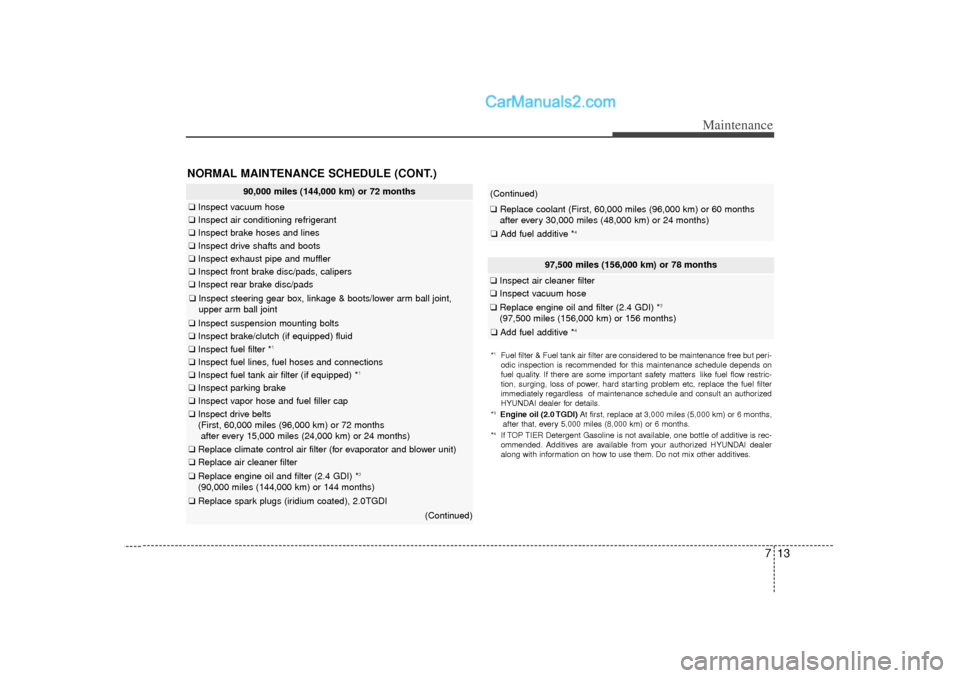
713
Maintenance
NORMAL MAINTENANCE SCHEDULE (CONT.)
97,500 miles (156,000 km) or 78 months
❑Inspect air cleaner filter❑Inspect vacuum hose❑Replace engine oil and filter (2.4 GDI) *
3
(97,500 miles (156,000 km) or 156 months)❑ Add fuel additive *
4
90,000 miles (144,000 km) or 72 months
❑Inspect vacuum hose❑Inspect air conditioning refrigerant❑Inspect brake hoses and lines❑Inspect drive shafts and boots❑Inspect exhaust pipe and muffler❑Inspect front brake disc/pads, calipers❑Inspect rear brake disc/pads❑Inspect steering gear box, linkage & boots/lower arm ball joint,
upper arm ball joint❑ Inspect suspension mounting bolts❑Inspect brake/clutch (if equipped) fluid ❑Inspect fuel filter *
1
❑Inspect fuel lines, fuel hoses and connections❑Inspect fuel tank air filter (if equipped) *
1
❑Inspect parking brake❑Inspect vapor hose and fuel filler cap❑Inspect drive belts
(First, 60,000 miles (96,000 km) or 72 months
after every 15,000 miles (24,000 km) or 24 months)❑ Replace climate control air filter (for evaporator and blower unit)❑Replace air cleaner filter❑Replace engine oil and filter (2.4 GDI) *
3
(90,000 miles (144,000 km) or 144 months)❑Replace spark plugs (iridium coated), 2.0TGDI
(Continued)
*1Fuel filter & Fuel tank air filter are considered to be maintenance free\
but peri-
odic inspection is recommended for this maintenance schedule depends on
fuel quality. If there are some important safety matters like fuel flow restric-
tion, surging, loss of power, hard starting problem etc, replace the fuel filter
immediately regardless of maintenance schedule and consult an authorized
HYUNDAI dealer for details.
*3Engine oil (2.0 TGDI) At first, replace at 3,000 miles (5,000 km) or 6 months,
after that, every 5,000 miles (8,000 km) or 6 months.
*4If TOP TIER Detergent Gasoline is not available, one bottle of additive is rec-
ommended. Additives are available from your authorized HYUNDAI dealer
along with information on how to use them. Do not mix other additives.(Continued)❑ Replace coolant (First, 60,000 miles (96,000 km) or 60 months
after every 30,000 miles (48,000 km) or 24 months)❑ Add fuel additive *
4
Page 331 of 411
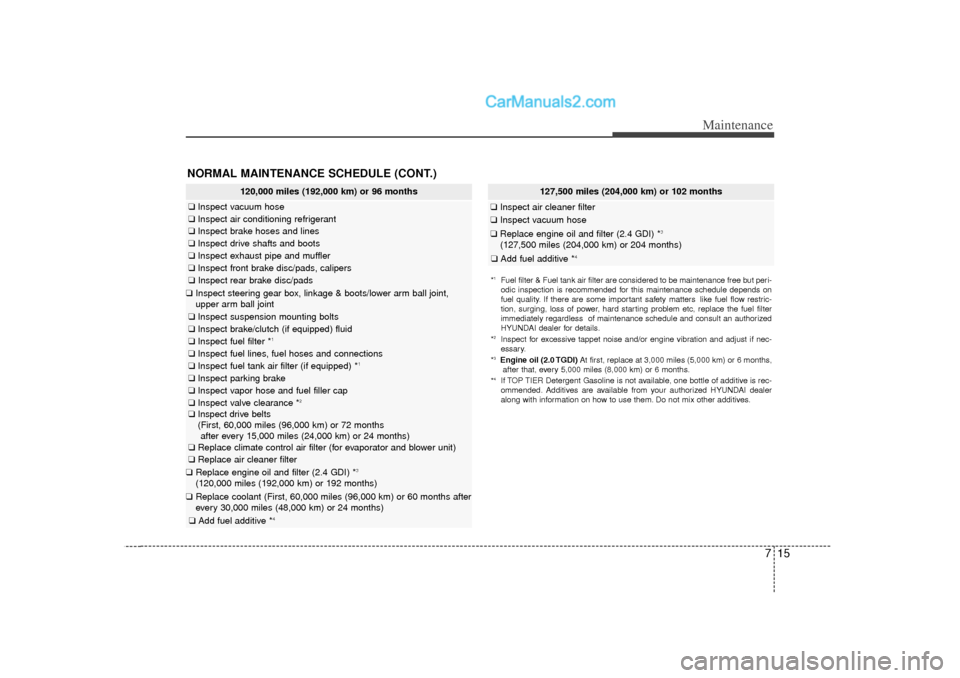
715
Maintenance
NORMAL MAINTENANCE SCHEDULE (CONT.)
120,000 miles (192,000 km) or 96 months
❑Inspect vacuum hose❑Inspect air conditioning refrigerant❑Inspect brake hoses and lines❑Inspect drive shafts and boots❑Inspect exhaust pipe and muffler❑Inspect front brake disc/pads, calipers❑Inspect rear brake disc/pads❑Inspect steering gear box, linkage & boots/lower arm ball joint,
upper arm ball joint❑ Inspect suspension mounting bolts❑Inspect brake/clutch (if equipped) fluid ❑Inspect fuel filter *
1
❑Inspect fuel lines, fuel hoses and connections❑Inspect fuel tank air filter (if equipped) *
1
❑Inspect parking brake❑Inspect vapor hose and fuel filler cap❑Inspect valve clearance *
2
❑Inspect drive belts
(First, 60,000 miles (96,000 km) or 72 months
after every 15,000 miles (24,000 km) or 24 months)❑ Replace climate control air filter (for evaporator and blower unit)❑Replace air cleaner filter❑Replace engine oil and filter (2.4 GDI) *
3
(120,000 miles (192,000 km) or 192 months)❑Replace coolant (First, 60,000 miles (96,000 km) or 60 months after
every 30,000 miles (48,000 km) or 24 months)❑ Add fuel additive *
4
*1Fuel filter & Fuel tank air filter are considered to be maintenance free\
but peri-
odic inspection is recommended for this maintenance schedule depends on
fuel quality. If there are some important safety matters like fuel flow restric-
tion, surging, loss of power, hard starting problem etc, replace the fuel filter
immediately regardless of maintenance schedule and consult an authorized
HYUNDAI dealer for details.
*2Inspect for excessive tappet noise and/or engine vibration and adjust if nec-
essary.
*3Engine oil (2.0 TGDI) At first, replace at 3,000 miles (5,000 km) or 6 months,
after that, every 5,000 miles (8,000 km) or 6 months.
*4If TOP TIER Detergent Gasoline is not available, one bottle of additive is rec-
ommended. Additives are available from your authorized HYUNDAI dealer
along with information on how to use them. Do not mix other additives.
127,500 miles (204,000 km) or 102 months
❑ Inspect air cleaner filter❑Inspect vacuum hose❑Replace engine oil and filter (2.4 GDI) *
3
(127,500 miles (204,000 km) or 204 months)❑ Add fuel additive *
4
Page 333 of 411
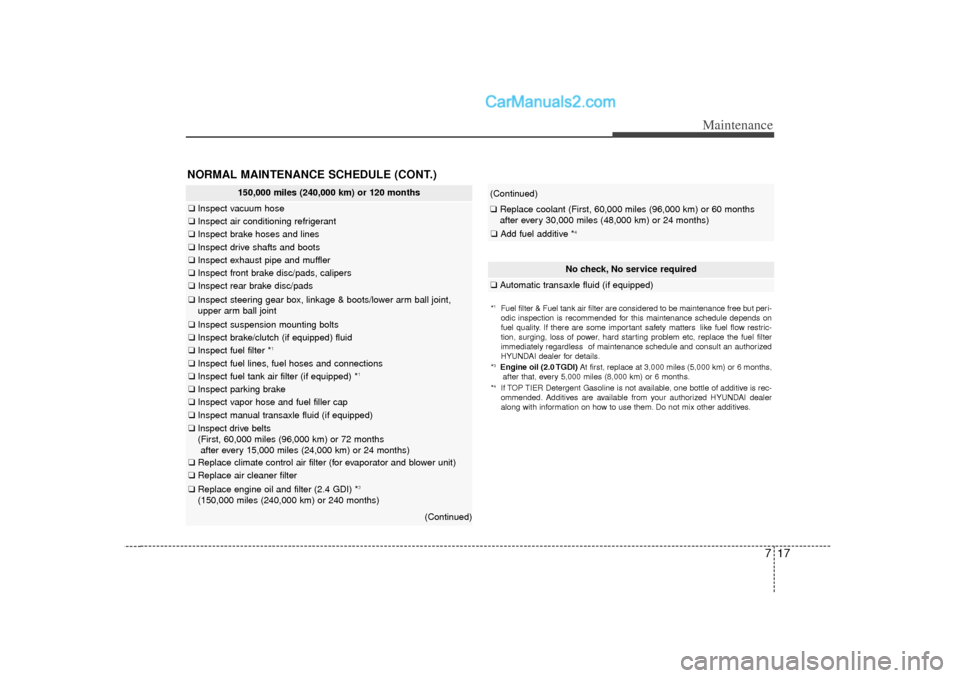
717
Maintenance
150,000 miles (240,000 km) or 120 months
❑Inspect vacuum hose❑Inspect air conditioning refrigerant❑Inspect brake hoses and lines❑Inspect drive shafts and boots❑Inspect exhaust pipe and muffler❑Inspect front brake disc/pads, calipers❑Inspect rear brake disc/pads❑Inspect steering gear box, linkage & boots/lower arm ball joint,
upper arm ball joint❑ Inspect suspension mounting bolts❑Inspect brake/clutch (if equipped) fluid ❑Inspect fuel filter *
1
❑Inspect fuel lines, fuel hoses and connections❑Inspect fuel tank air filter (if equipped) *
1
❑Inspect parking brake❑Inspect vapor hose and fuel filler cap❑Inspect manual transaxle fluid (if equipped)❑Inspect drive belts
(First, 60,000 miles (96,000 km) or 72 months
after every 15,000 miles (24,000 km) or 24 months)❑ Replace climate control air filter (for evaporator and blower unit)❑Replace air cleaner filter❑Replace engine oil and filter (2.4 GDI) *
3
(150,000 miles (240,000 km) or 240 months)
(Continued)
(Continued)❑Replace coolant (First, 60,000 miles (96,000 km) or 60 months
after every 30,000 miles (48,000 km) or 24 months)❑ Add fuel additive *
4
NORMAL MAINTENANCE SCHEDULE (CONT.)
No check, No service required
❑Automatic transaxle fluid (if equipped)*1Fuel filter & Fuel tank air filter are considered to be maintenance free\
but peri-
odic inspection is recommended for this maintenance schedule depends on
fuel quality. If there are some important safety matters like fuel flow restric-
tion, surging, loss of power, hard starting problem etc, replace the fuel filter
immediately regardless of maintenance schedule and consult an authorized
HYUNDAI dealer for details.
*3Engine oil (2.0 TGDI) At first, replace at 3,000 miles (5,000 km) or 6 months,
after that, every 5,000 miles (8,000 km) or 6 months.
*4If TOP TIER Detergent Gasoline is not available, one bottle of additive is rec-
ommended. Additives are available from your authorized HYUNDAI dealer
along with information on how to use them. Do not mix other additives.
Page 336 of 411
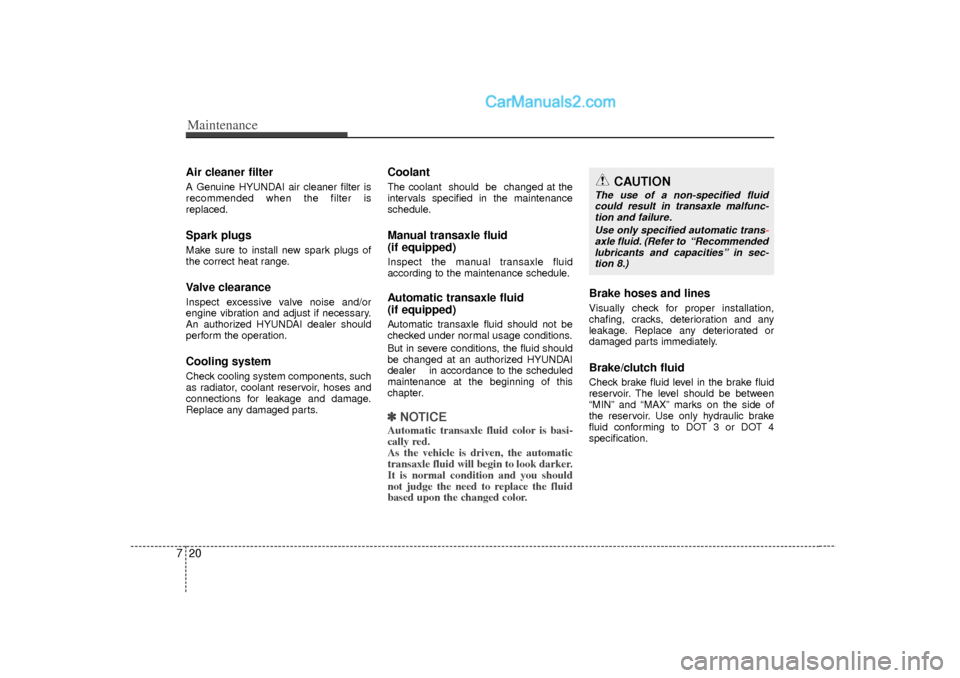
Maintenance20
7Air cleaner filterA Genuine HYUNDAI air cleaner filter is
recommended when the filter is
replaced.Spark plugsMake sure to install new spark plugs of
the correct heat range.Valve clearance Inspect excessive valve noise and/or
engine vibration and adjust if necessary.
An authorized HYUNDAI dealer should
perform the operation.Cooling systemCheck cooling system components, such
as radiator, coolant reservoir, hoses and
connections for leakage and damage.
Replace any damaged parts.
CoolantThe coolant should be changed at the
intervals specified in the maintenance
schedule.Manual transaxle fluid
(if equipped)Inspect the manual transaxle fluid
according to the maintenance schedule.Automatic transaxle fluid
(if equipped)Automatic transaxle fluid should not be
checked under normal usage conditions.
But in severe conditions, the fluid should
be changed at an authorized HYUNDAI
dealer in accordance to the scheduled
maintenance at the beginning of this
chapter.✽ ✽
NOTICEAutomatic transaxle fluid color is basi-
cally red.
As the vehicle is driven, the automatic
transaxle fluid will begin to look darker.
It is normal condition and you should
not judge the need to replace the fluid
based upon the changed color.
Brake hoses and linesVisually check for proper installation,
chafing, cracks, deterioration and any
leakage. Replace any deteriorated or
damaged parts immediately.Brake/clutch fluidCheck brake fluid level in the brake fluid
reservoir. The level should be between
“MIN” and “MAX” marks on the side of
the reservoir. Use only hydraulic brake
fluid conforming to DOT 3 or DOT 4
specification.
CAUTION
The use of a non-specified fluid
could result in transaxle malfunc- tion and failure.
Use only specified automatic trans -
axle fluid. (Refer to “Recommended lubricants and capacities” in sec-tion 8.)
Page 342 of 411
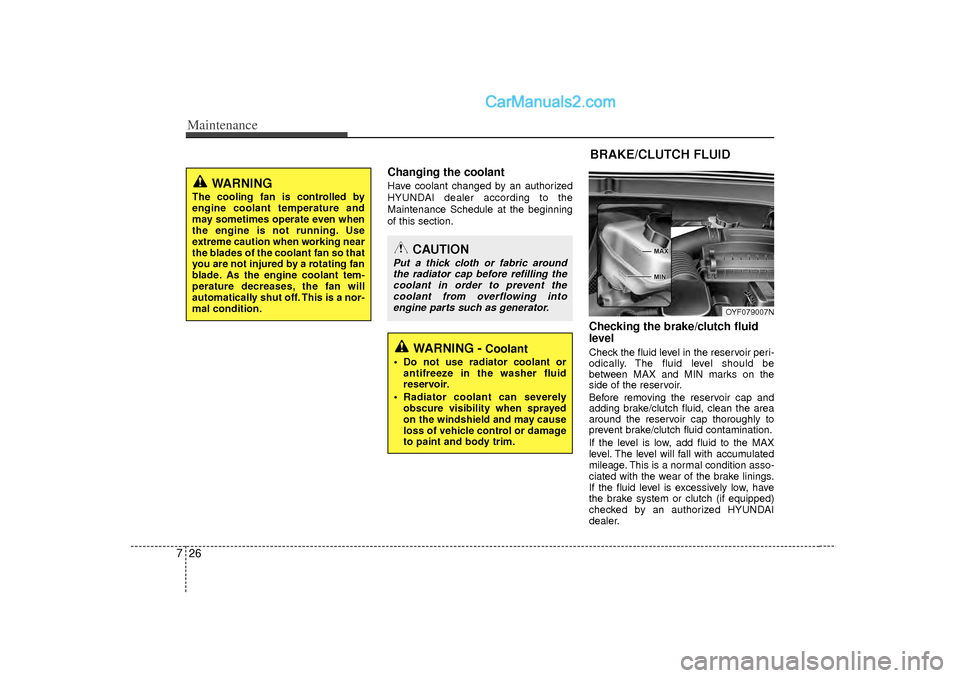
Maintenance26
7
Changing the coolantHave coolant changed by an authorized
HYUNDAI dealer according to the
Maintenance Schedule at the beginning
of this section.
Checking the brake/clutch fluid
level Check the fluid level in the reservoir peri-
odically. The fluid level should be
between MAX and MIN marks on the
side of the reservoir.
Before removing the reservoir cap and
adding brake/clutch fluid, clean the area
around the reservoir cap thoroughly to
prevent brake/clutch fluid contamination.
If the level is low, add fluid to the MAX
level. The level will fall with accumulated
mileage. This is a normal condition asso-
ciated with the wear of the brake linings.
If the fluid level is excessively low, have
the brake system or clutch (if equipped)
checked by an authorized HYUNDAI
dealer.
OYF079007N
BRAKE/CLUTCH FLUID
WARNING -
Coolant
Do not use radiator coolant or
antifreeze in the washer fluid
reservoir.
Radiator coolant can severely obscure visibility when sprayed
on the windshield and may cause
loss of vehicle control or damage
to paint and body trim.
CAUTION
Put a thick cloth or fabric aroundthe radiator cap before refilling thecoolant in order to prevent the coolant from overflowing intoengine parts such as generator.
WARNING
The cooling fan is controlled by
engine coolant temperature and
may sometimes operate even when
the engine is not running. Use
extreme caution when working near
the blades of the coolant fan so that
you are not injured by a rotating fan
blade. As the engine coolant tem-
perature decreases, the fan will
automatically shut off. This is a nor-
mal condition.
Page 343 of 411
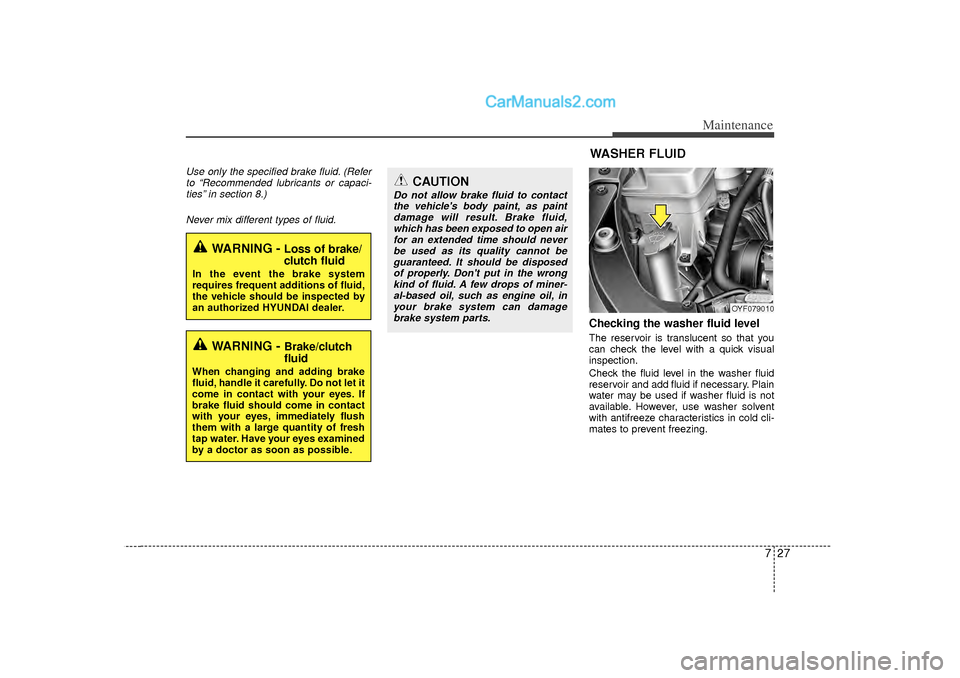
727
Maintenance
Use only the specified brake fluid. (Referto “Recommended lubricants or capaci-ties” in section 8.)
Never mix different types of fluid.
Checking the washer fluid level The reservoir is translucent so that you
can check the level with a quick visual
inspection.
Check the fluid level in the washer fluid
reservoir and add fluid if necessary. Plain
water may be used if washer fluid is not
available. However, use washer solvent
with antifreeze characteristics in cold cli-
mates to prevent freezing.
OYF079010
WARNING -
Brake/clutch
fluid
When changing and adding brake
fluid, handle it carefully. Do not let it
come in contact with your eyes. If
brake fluid should come in contact
with your eyes, immediately flush
them with a large quantity of fresh
tap water. Have your eyes examined
by a doctor as soon as possible.
WARNING -
Loss of brake/
clutch fluid
In the event the brake system
requires frequent additions of fluid,
the vehicle should be inspected by
an authorized HYUNDAI dealer.
CAUTION
Do not allow brake fluid to contactthe vehicle's body paint, as paintdamage will result. Brake fluid,which has been exposed to open air for an extended time should neverbe used as its quality cannot beguaranteed. It should be disposedof properly. Don't put in the wrong kind of fluid. A few drops of miner-al-based oil, such as engine oil, inyour brake system can damage brake system parts.
WASHER FLUID
Page 396 of 411
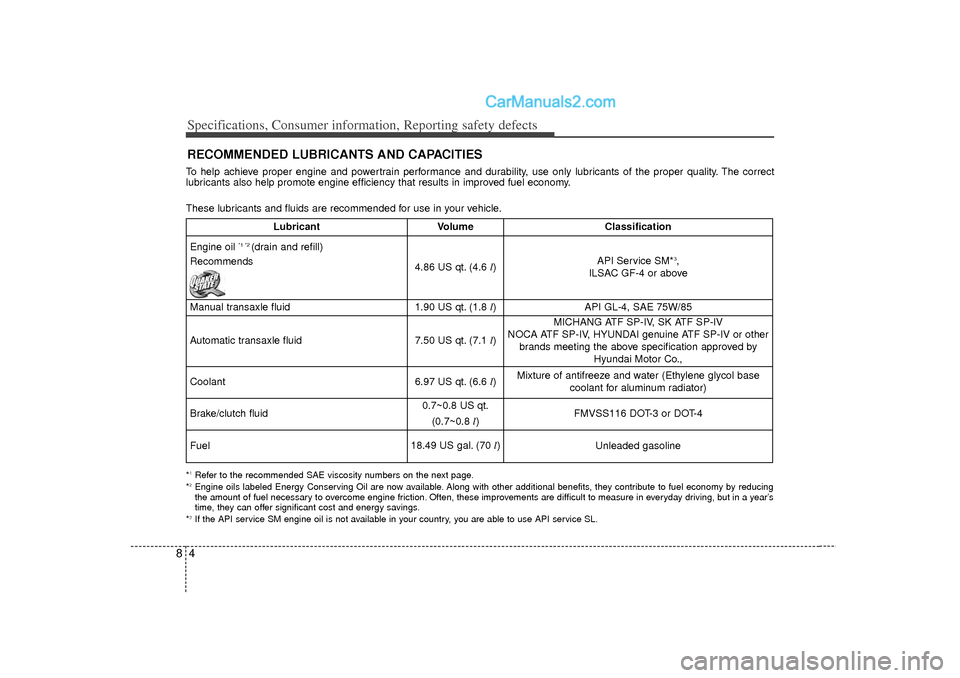
Specifications, Consumer information, Reporting safety defects48RECOMMENDED LUBRICANTS AND CAPACITIES To help achieve proper engine and powertrain performance and durability, use only lubricants of the proper quality. The correct
lubricants also help promote engine efficiency that results in improved fuel economy.These lubricants and fluids are recommended for use in your vehicle.*1Refer to the recommended SAE viscosity numbers on the next page.
*2Engine oils labeled Energy Conserving Oil are now available. Along with other additional benefits, they contribute to fuel econo my by reducing
the amount of fuel necessary to overcome engine friction. Often, these improvements are difficult to measure in everyday driving, but in a year’s
time, they can offer significant cost and energy savings.
*3If the API service SM engine oil is not available in your country, you are able to use API service SL.
Lubricant
Volume
Classification
Engine oil
*1 *2
(drain and refill)
Recommends
4.86 US qt. (4.6 l)
API Service SM*
3,
ILSAC GF-4 or above
Manual transaxle fluid
1.90 US qt. (1.8 l)
API GL-4, SAE 75W/85
Automatic transaxle fluid
7.50 US qt. (7.1 l)
MICHANG ATF SP-IV, SK ATF SP-IV
NOCA ATF SP-IV, HYUNDAI genuine ATF SP-IV or other brands meeting the above specification approved by Hyundai Motor Co.,
Coolant
6.97 US qt. (6.6 l)
Mixture of antifreeze and water (Ethylene glycol base
coolant for aluminum radiator)
Brake/clutch fluid
0.7~0.8 US qt.
(0.7~0.8 l)
FMVSS116 DOT-3 or DOT-4
Fuel
18.49 US gal. (70 l)
Unleaded gasoline
Page 403 of 411
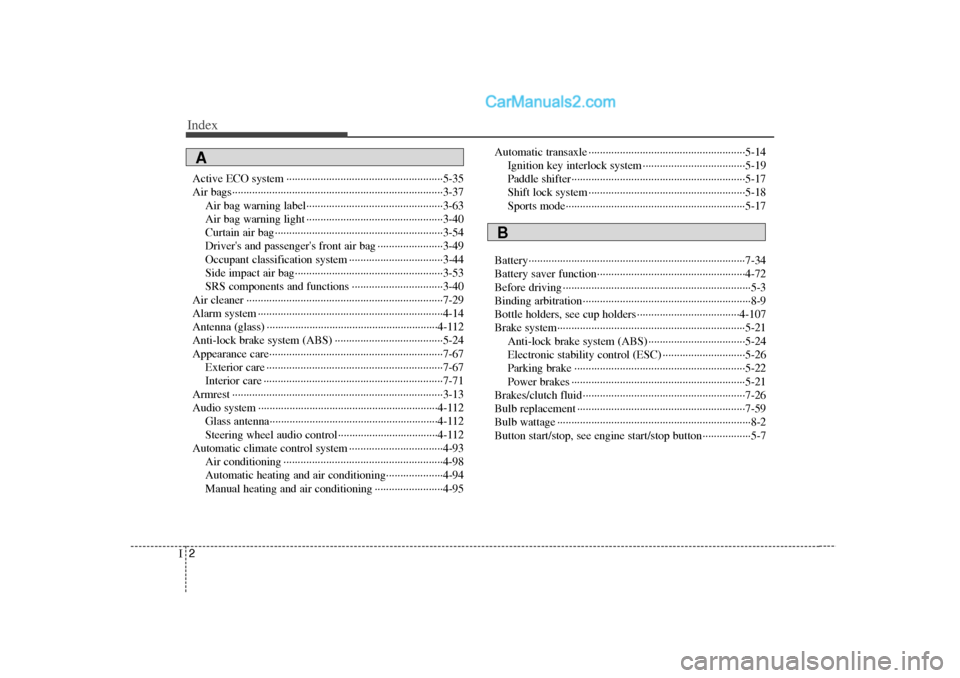
Index2I
Active ECO system ··················\
··················\
··················\
·5-35
Air bags··················\
··················\
··················\
··················\
··3-37Air bag warning label··················\
··················\
············3-63
Air bag warning light ··················\
··················\
············3-40
Curtain air bag··················\
··················\
··················\
·····3-54
Driver's and passenger's front air bag ··················\
·····3-49
Occupant classification system ··················\
···············3-44
Side impact air bag··················\
··················\
················3-53
SRS components and functions ··················\
··············3-40
Air cleaner ··················\
··················\
··················\
···············7-29
Alarm system ··················\
··················\
··················\
···········4-14
Antenna (glass) ··················\
··················\
··················\
······4-112
Anti-lock brake system (ABS) ··················\
··················\
··5-24
Appearance care··················\
··················\
··················\
·······7-67 Exterior care ··················\
··················\
··················\
········7-67
Interior care ··················\
··················\
··················\
·········7-71
Armrest ··················\
··················\
··················\
··················\
··3-13
Audio system ··················\
··················\
··················\
·········4-112 Glass antenna··················\
··················\
··················\
·····4-112
Steering wheel audio control··················\
·················4-112
Automatic climate control system ··················\
···············4-93 Air conditioning ··················\
··················\
··················\
··4-98
Automatic heating and air conditioning··················\
··4-94
Manual heating and air conditioning ··················\
······4-95 Automatic transaxle ··················\
··················\
··················\
·5-14
Ignition key interlock system ··················\
··················\
5-19
Paddle shifter··················\
··················\
··················\
·······5-17
Shift lock system ··················\
··················\
··················\
·5-18
Sports mode··················\
··················\
··················\
·········5-17
Battery··················\
··················\
··················\
··················\
····7-34
Battery saver function··················\
··················\
················4-72
Before driving ··················\
··················\
··················\
············5-3
Binding arbitration ··················\
··················\
··················\
·····8-9
Bottle holders, see cup holders ··················\
··················\
4-107
Brake system··················\
··················\
··················\
············5-21 Anti-lock brake system (ABS) ··················\
················5-24
Electronic stability control (ESC) ··················\
···········5-26
Parking brake ··················\
··················\
··················\
······5-22
Power brakes ··················\
··················\
··················\
·······5-21
Brakes/clutch fluid ··················\
··················\
··················\
···7-26
Bulb replacement ··················\
··················\
··················\
·····7-59
Bulb wattage ··················\
··················\
··················\
··············8-2
Button start/stop, see engine start/stop button·················5-7A
B
Page 405 of 411
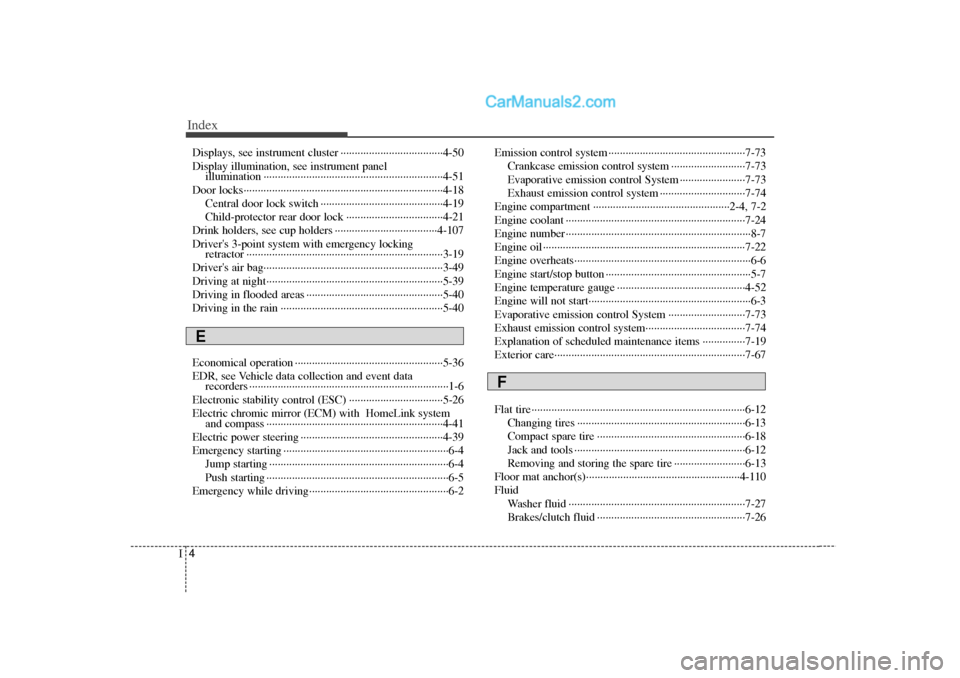
Index4I
Displays, see instrument cluster ··················\
··················\
4-50
Display illumination, see instrument panelillumination ··················\
··················\
··················\
·········4-51
Door locks··················\
··················\
··················\
················4-18 Central door lock switch ··················\
··················\
·······4-19
Child-protector rear door lock ··················\
················4-21
Drink holders, see cup holders ··················\
··················\
4-107
Driver's 3-point system with emergency locking retractor ··················\
··················\
··················\
···············3-19
Driver's air bag··············\
··················\
··················\
·············3-49
Driving at night··················\
··················\
··················\
········5-39
Driving in flooded areas ··················\
··················\
············5-40
Driving in the rain ··················\
··················\
··················\
···5-40
Economical operation ··················\
··················\
················5-36
EDR, see Vehicle data collection and event data recorders ··················\
··················\
··················\
················1-6
Electronic stability control (ESC) ··················\
···············5-26
Electric chromic mirror (ECM) with HomeLink system and compass ··················\
··················\
··················\
········4-41
Electric power steering ··················\
··················\
··············4-39
Emergency starting ··················\
··················\
··················\
····6-4 Jump starting ··················\
··················\
··················\
·········6-4
Push starting ··················\
··················\
··················\
··········6-5
Emergency while driving··················\
··················\
·············6-2 Emission control system ··················\
··················\
············7-73
Crankcase emission control system ··················\
········7-73
Evaporative emission control System ··················\
·····7-73
Exhaust emission control system ··················\
············7-74
Engine compartment ··················\
··················\
············2-4, 7-2
Engine coolant ··················\
··················\
··················\
·········7-24
Engine number ··················\
··················\
··················\
···········8-7
Engine oil ··················\
··················\
··················\
·················7-22\
Engine overheats··················\
··················\
··················\
········6-6
Engine start/stop button ··················\
··················\
···············5-7
Engine temperature gauge ··················\
··················\
·········4-52
Engine will not start··················\
··················\
··················\
···6-3
Evaporative emission control System ··················\
·········7-73
Exhaust emission control system··················\
·················7-74\
Explanation of scheduled maintenance items ···············7-19
Exterior care··················\
··················\
··················\
·············7-67
Flat tire ··················\
··················\
··················\
··················\
···6-12 Changing tires ··················\
··················\
··················\
·····6-13
Compact spare tire ··················\
··················\
················6-18
Jack and tools ··················\
··················\
··················\
······6-12
Removing and storing the spare tire ··················\
·······6-13
Floor mat anchor(s)··················\
··················\
··················\
4-110
Fluid Washer fluid ··················\
··················\
··················\
········7-27
Brakes/clutch fluid ··················\
··················\
················7-26E
F